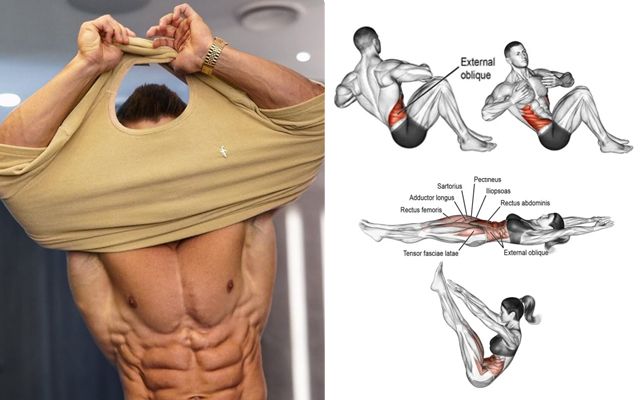The Renegade Row is a powerful exercise that you might have seen at the gym or in workout routines. It’s a great way to build strength and balance, and it doesn’t require any fancy equipment—just a pair of dumbbells. In this article, we’ll explore why the Renegade Row is so effective. We’ll look at how it helps strengthen your core, tones your upper body, and improves your balance. Plus, we’ll share some tips on how to do it correctly and how to add it to your workout routine. Whether you’re a fitness beginner or a seasoned athlete, learning about the Renegade Row can help you get more out of your workouts and reach your fitness goals.
Introduction to Renegade Row
The renegade row is a dynamic and challenging exercise that combines the benefits of a plank and a row. It is a compound movement that targets multiple muscle groups, making it an efficient addition to any workout routine. Essentially, a renegade row involves holding a plank position while performing a rowing motion with one arm at a time. This exercise requires a pair of dumbbells or kettlebells and engages the core, back, shoulders, and arms.
SHOP FOR THE ADJUSTABLE DUMBBELL SET ON AMAZON
The renegade row has its roots in functional fitness and strength training. It has gained popularity in recent years due to its effectiveness in building core stability and overall strength. The exercise is often included in high-intensity interval training (HIIT) workouts and strength training programs. By incorporating the renegade row into your fitness routine, you can enhance your core stability, improve unilateral strength, and engage multiple muscle groups simultaneously. It’s a versatile exercise that can be adapted to various fitness levels and goals.
Benefits of Renegade Row

The renegade row is a powerhouse exercise with numerous benefits that can enhance your fitness routine. Here are some of the key benefits:
- Core Stability: The renegade row is excellent for building core stability. By holding a plank position while performing the rowing motion, your core muscles are constantly engaged to maintain balance and stability. This helps to strengthen the entire core, including the rectus abdominis, obliques, and transverse abdominis.
- Unilateral Strength and Balance: Since the renegade row is performed one arm at a time, it helps to develop unilateral strength and balance. This means that each side of your body works independently, which can help to correct muscle imbalances and improve overall strength and coordination.
- Total Body Movement: The renegade row is a compound exercise that engages multiple muscle groups simultaneously. It works the back, shoulders, arms, and core, making it a highly efficient exercise for building overall strength and muscle tone.
- Metabolic Boost: Incorporating the renegade row into your workout can give your metabolism a significant boost. The combination of strength training and core engagement helps to increase calorie burn, both during and after your workout. This makes it an effective exercise for weight loss and improving metabolic health.
- Scapular Stability and Control: The rowing motion in the renegade row helps to enhance scapular stability and control. This is important for maintaining healthy shoulder function and preventing injuries. Strengthening the muscles around the shoulder blades can improve posture and reduce the risk of shoulder-related issues.
- Functional Strength: Renegade rows mimic real-world movements, enhancing functional strength essential for daily activities and sports. This makes it a practical exercise that translates well to everyday life.
- Improved Posture: Strengthening the upper back muscles through renegade rows contributes to better posture. This can help reduce the risk of slouching and related issues, promoting a healthier spine and overall body alignment.
- Efficient Core Activation: The renegade row is highly effective for core activation. By maintaining a plank position while rowing, the exercise engages the deep core muscles, improving core strength and stability.
- Increased Muscle Endurance: Incorporating renegade rows into your routine can help increase overall muscle endurance. This is particularly beneficial for athletes and individuals looking to improve their stamina and performance in various physical activities.
- Minimal Equipment and Space: One of the great advantages of the renegade row is that it requires minimal equipment and space. All you need is a pair of dumbbells or kettlebells, making it a convenient exercise to perform at home or in a gym with limited space.
- Movement for Infinite Progressions: The renegade row offers endless possibilities for progression. You can increase the weight, change the tempo, or incorporate it into different workout routines to continually challenge your muscles and improve your fitness level.
SHOP FOR THE KETTLEBELLS ON AMAZON
By incorporating the renegade row into your fitness routine, you can enjoy these benefits and more. It’s a versatile exercise that can be adapted to various fitness levels and goals, making it a valuable addition to any workout program.
Muscles Worked in Renegade Row Exercise

The Renegade Row is a highly effective exercise that targets multiple muscle groups simultaneously. Here’s a breakdown of the key muscles worked:
Primary Muscles Worked:
- Latissimus Dorsi: These are the large muscles in your back that help with pulling movements.
- Rhomboids: Located between the shoulder blades, these muscles are involved in retracting the scapula.
- Trapezius: This muscle extends from the back of the neck down to the middle of the back and helps stabilize and move the shoulder blades.
- Biceps Brachii: Located in the upper arm, the biceps are engaged during the rowing motion.
- Core Muscles (Rectus Abdominis, Obliques, and Transverse Abdominis): These muscles are heavily engaged to stabilize your body and maintain proper form during the exercise.
Secondary Muscles Worked:
- Shoulders (Deltoids): The shoulders help stabilize the movement and assist with the rowing action.
- Erector Spinae: These are the muscles running along your spine that assist in keeping your back straight.
- Forearms: The forearm muscles are engaged to grip the dumbbells and assist in the rowing motion.
- Glutes: The gluteal muscles help maintain body stability and alignment, especially when your feet are elevated.
By working these muscle groups, the Renegade Row offers a comprehensive workout that builds strength, stability, and endurance across the upper body and core.
How to Perform Renegade Row

Performing the renegade row correctly is crucial to maximize its benefits and avoid injury. Here’s a detailed step-by-step guide:
- Starting Position: Begin in a full plank position with a dumbbell in each hand, palms facing each other. Your hands should be directly under your shoulders, and your feet should be slightly wider than hip-width apart for better stability.
- Engage Your Core: Keep your body in a straight line from head to heels. Engage your core muscles to maintain stability and prevent your hips from sagging or rotating.
- Rowing Motion: Shift your weight slightly to one side while keeping your body stable. Pull the dumbbell in your right hand towards your right hip, keeping your elbow close to your body. Squeeze your shoulder blade as you row the dumbbell upwards.
- Lower the Dumbbell: Slowly lower the dumbbell back to the starting position with control. Avoid dropping the weight or letting your body twist.
- Repeat on the Other Side: Shift your weight to the other side and repeat the rowing motion with your left hand. Ensure that your core remains engaged and your body stays in a straight line throughout the movement.
- Breathing: Inhale as you prepare and engage your core. Exhale as you row the dumbbell upwards.
- Repetitions: Perform the desired number of repetitions on each side, maintaining proper form throughout.
SHOP FOR THE RESISTANCE BAND ON AMAZON
By following these steps and focusing on proper form, you can effectively perform the renegade row and reap its numerous benefits.
Common Mistakes to Avoid in Renegade Row
Here are some common mistakes to avoid when performing the Renegade Row:
Squats vs. Bulgarian Split Squats
- Lack of Core Engagement: Many people forget to engage their core during the exercise, which can lead to instability and lower back strain. Tip: Tighten your abs and keep your hips stable throughout the movement.
- Sagging Hips: Allowing your hips to drop or twist can compromise your form and effectiveness. Tip: Maintain a straight line from your head to your heels, and keep your hips level as you row.
- Improper Hand Placement: Placing your hands too far apart or too close together can affect balance and form. Tip: Position your hands directly under your shoulders to ensure proper alignment and stability.
- Using Too Much Momentum: Relying on momentum rather than muscle control can reduce the exercise’s effectiveness and increase the risk of injury. Tip: Focus on controlled, deliberate movements, and avoid jerking or swinging.
- Incorrect Rowing Technique: Pulling the dumbbell too high or too low can lead to poor muscle engagement. Tip: Row the dumbbell to your ribcage or chest level, keeping your elbow close to your body.
- Not Keeping a Neutral Neck: Looking up or down can strain your neck and affect your form. Tip: Keep your head in a neutral position, with your gaze directed towards the floor or slightly forward.
- Uneven Weight Distribution: Placing more weight on one side or shifting your weight can lead to imbalances and instability. Tip: Distribute your weight evenly between your hands and feet, and ensure a stable base.
SHOP FOR THE WEIGHT BENCH ON AMAZON
By being mindful of these common mistakes and focusing on proper technique, you can maximize the benefits of the Renegade Row while minimizing the risk of injury.
Different Variations of the Renegade Row
Exploring different variations of the renegade row can add variety to your workouts and target different muscle groups. Here are some popular variations:
1. Renegade Row with Push-Up
- How to do: Start in a plank position with a dumbbell in each hand. Perform a push-up by lowering your chest to the ground and then pushing back up. After the push-up, row one dumbbell towards your hip while keeping your core engaged and hips stable. Repeat on the other side.
- Benefits: This variation enhances chest, triceps, and core strength by combining the push-up with the rowing motion, providing a full upper-body workout.
2. Bear Plank Renegade Row
- How to do: Begin in a bear plank position with your knees bent at 90 degrees and hovering just above the ground. Hold a dumbbell in each hand. Perform the row by pulling one dumbbell towards your hip while maintaining the bear plank position. Alternate sides.
- Benefits: This variation increases core stability and engages the lower body, particularly the quads and glutes, due to the bear plank position.
3. Renegade Row with Rotation
- How to do: Start in a plank position with a dumbbell in each hand. As you row one dumbbell towards your hip, rotate your torso and extend the dumbbell upwards, reaching towards the ceiling. Return to the starting position and repeat on the other side.
- Benefits: This variation engages the obliques and improves rotational strength, enhancing overall core stability and functional movement.
4. Single-Arm Renegade Row
- How to do: Start in a plank position with one hand on a dumbbell and the other hand on the ground. Row the dumbbell towards your hip while keeping your core engaged and hips stable. Switch sides after completing the desired number of repetitions.
- Benefits: This variation focuses on unilateral strength and balance, helping to correct muscle imbalances and improve coordination.
5. Kettlebell Renegade Row
- How to do: Use kettlebells instead of dumbbells for a different grip and challenge. Start in a plank position with a kettlebell in each hand. Perform the row by pulling one kettlebell towards your hip while keeping your core engaged and hips stable. Alternate sides.
- Benefits: This variation enhances grip strength and provides a different stimulus to the muscles due to the unique shape and weight distribution of kettlebells.
6. Renegade Row with Plank Hold
- How to do: Start in a plank position with a dumbbell in each hand. Perform the row by pulling one dumbbell towards your hip, then hold the plank position for a few seconds before repeating on the other side.
- Benefits: This variation improves core endurance and stability by adding an isometric hold between each rowing motion.
7. Renegade Row with Tempo Change
- How to do: Start in a plank position with a dumbbell in each hand. Perform the row by pulling one dumbbell towards your hip slowly, taking 3-5 seconds to complete the movement. Lower the dumbbell back to the starting position with the same slow tempo. Alternate sides.
- Benefits: This variation enhances muscle control and strength by increasing the time under tension, making the muscles work harder.
8. Renegade Row with Resistance Bands
- How to do: Attach resistance bands to the dumbbells or kettlebells for added resistance. Start in a plank position with a dumbbell in each hand and resistance bands attached to the dumbbells. Perform the row by pulling one dumbbell towards your hip while maintaining tension in the resistance bands. Alternate sides.
- Benefits: This variation increases resistance and challenges the muscles differently, providing a unique stimulus for muscle growth and strength.
SHOP FOR THE FITNESS TRACKER ON AMAZON
By incorporating these variations into your fitness routine, you can continually challenge your muscles and avoid plateaus.
How to Modify the Exercise to Increase or Decrease Difficulty
Modifying the renegade row exercise can help you tailor it to your fitness level, whether you want to increase or decrease the difficulty. Here are some ways to adjust the exercise:
To Decrease Difficulty
- Use Lighter Weights: Starting with lighter dumbbells or kettlebells can make the renegade row more manageable, especially for beginners.
- Perform on an Incline: Elevating your upper body by placing your hands on a step or sturdy platform can decrease the intensity of the exercise.
- Drop to Your Knees: Performing the renegade row from a modified plank position with your knees on the ground can take some stress off your core and lower back.
- Reduce Range of Motion: Limiting the range of motion by not pulling the dumbbell all the way to your hip can make the exercise less challenging.
To Increase Difficulty
- Use Heavier Weights: Increasing the weight of the dumbbells or kettlebells adds more resistance, challenging your muscles further.
- Perform on a Decline: Elevating your feet on a sturdy bench or box increases the difficulty of the exercise by adding more body weight to the movement.
- Add a Push-Up: Incorporating a push-up between each row adds an extra challenge to your upper body and core. This modification enhances chest, triceps, and core strength, providing a full upper-body workout.
- Slow Down the Tempo: Performing the rowing motion slowly increases time under tension, making the muscles work harder.
- Use Resistance Bands: Attaching resistance bands to the dumbbells or kettlebells adds extra resistance, providing a unique stimulus for muscle growth and strength.
- Single-Arm Renegade Row: Performing the row with one arm while the other hand is placed on the ground for added stability focuses on unilateral strength and balance. This modification helps correct muscle imbalances and improves coordination, making the exercise more challenging.
By adjusting these variables, you can modify the renegade row to suit your fitness level and goals.
FAQs
Q 1. What equipment do I need for a renegade row?
Ans. You will need a pair of dumbbells or kettlebells and a flat, stable surface to perform the exercise.
Q 2. You will need a pair of dumbbells or kettlebells and a flat, stable surface to perform the exercise.
Ans. It depends on your fitness goals, but generally, 2-3 times per week is a good starting point.
Q 3. Are there any alternatives to the renegade row for similar benefits?
Ans. Yes, alternatives include bent-over rows, plank rows, and TRX rows, which also target similar muscle groups.
Q 4. Can I perform renegade rows as part of a HIIT workout?
Ans. Yes, renegade rows can be incorporated into high-intensity interval training (HIIT) workouts for added intensity and metabolic benefits.
Q 5. What is the ideal weight to start with for renegade rows?
Ans. Beginners should start with lighter weights, such as 5-10 pounds, to focus on form and stability. Gradually increase the weight as you become more comfortable and stronger.
Q 6. Can renegade rows help with weight loss?
Ans. Yes, renegade rows can aid in weight loss as they are a compound exercise that engages multiple muscle groups, increasing caloric expenditure and boosting metabolism.
Conclusion
In conclusion, the Renegade Row is a powerful exercise that offers a range of benefits for your body. It helps build a strong core, improves upper body strength, and boosts your overall balance and coordination. By including Renegade Rows in your workout routine, you can enhance your fitness and work toward your goals more effectively. Whether you’re looking to burn calories, increase muscle strength, or just add variety to your exercise regimen, the Renegade Row is a great choice.

Good day, and welcome to Fitthour. My name is Shubham Vijay, and I am a certified personal trainer and nutrition coach with 6 years of experience in the fitness industry. At Fitthour, we specialize in types of training, such as strength training, cardio, or HIIT, and our mission is to help clients achieve their fitness goals and improve their overall health.



